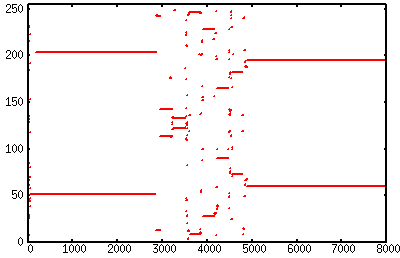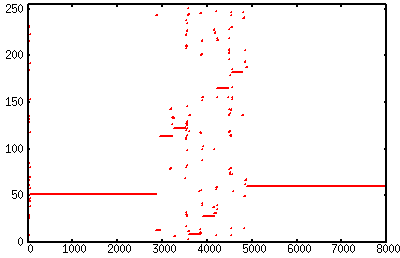The center images are screenshots from my TurboTape loader during load. It switches screencolor each time a negative flank is detected, or a bit is loaded respectively.
(btw, if you want to load the PRG or TAP file yourself, launch with SYS 8000)
The higher frequency for 0 bits is obvious. Time for some numbers:
In this TAP format a 0 bit is encoded as $1a and a 1 bit as $28.
Multiplied by 8 you get the amount of cycles:
bit 0: 208 cycles
bit 1: 320 cycles
Divided by the amount of cycles per rasterline you get roughly about 3 lines versus 5 lines between consecutive signals. This is a difference of 35%! After all the black image loads about 25% faster (since it does include a displaycode and white areas).
Data in test1.tap consists of 10.038 0-bits and 63.602 1-bits.
Data in test2.tap consists of 70.786 0-bits and 2.854 1-bits.
(uneqal ratios due to displaycode)
Packers/crunchers for use with tape should thus try to favor 0 bits. A simple approach would be a mere EOR over all data to achieve the maximum amount of 0 bits.
And some additional information:
Including a header and leading/secluding pauses, the speed at which the 2nd image loads is about 3660 baud = 458 Byte/s. That beats the ROM-loader for the 1541 Floppy with about 400 Byte/s. For Turbo Tape the loading speed ranges from amazing 4740 Baud (0 bits only) to 3080 baud (1 bits only). In average 3900 baud but without the pauses and the header, so expect about 3800 baud for large files.
(note that these estimates are the average speeds over a whole file, not the streaming values which are higher of course).
|





